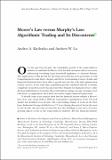Moore's Law versus Murphy's Law: Algorithmic Trading and Its Discontents
Author(s)
Kirilenko, Andrei; Lo, Andrew W.
DownloadLo-Moore's law.pdf (538.3Kb)
PUBLISHER_POLICY
Publisher Policy
Article is made available in accordance with the publisher's policy and may be subject to US copyright law. Please refer to the publisher's site for terms of use.
Terms of use
Metadata
Show full item recordAbstract
Financial markets have undergone a remarkable transformation over the past two decades due to advances in technology. These advances include faster and cheaper computers, greater connectivity among market participants, and perhaps most important of all, more sophisticated trading algorithms. The benefits of such financial technology are evident: lower transactions costs, faster executions, and greater volume of trades. However, like any technology, trading technology has unintended consequences. In this paper, we review key innovations in trading technology starting with portfolio optimization in the 1950s and ending with high-frequency trading in the late 2000s, as well as opportunities, challenges, and economic incentives that accompanied these developments. We also discuss potential threats to financial stability created or facilitated by algorithmic trading and propose "Financial Regulation 2.0," a set of design principles for bringing the current financial regulatory framework into the Digital Age.
Date issued
2013-02Department
Sloan School of ManagementJournal
Journal of Economic Perspectives
Publisher
American Economic Association
Citation
Kirilenko, Andrei A, and Andrew W Lo. “Moore’s Law Versus Murphy’s Law: Algorithmic Trading and Its Discontents.” Journal of Economic Perspectives 27, no. 2 (February 2013): 51–72. © 2013 by the American Economic Association
Version: Final published version
ISSN
0895-3309
1944-7965